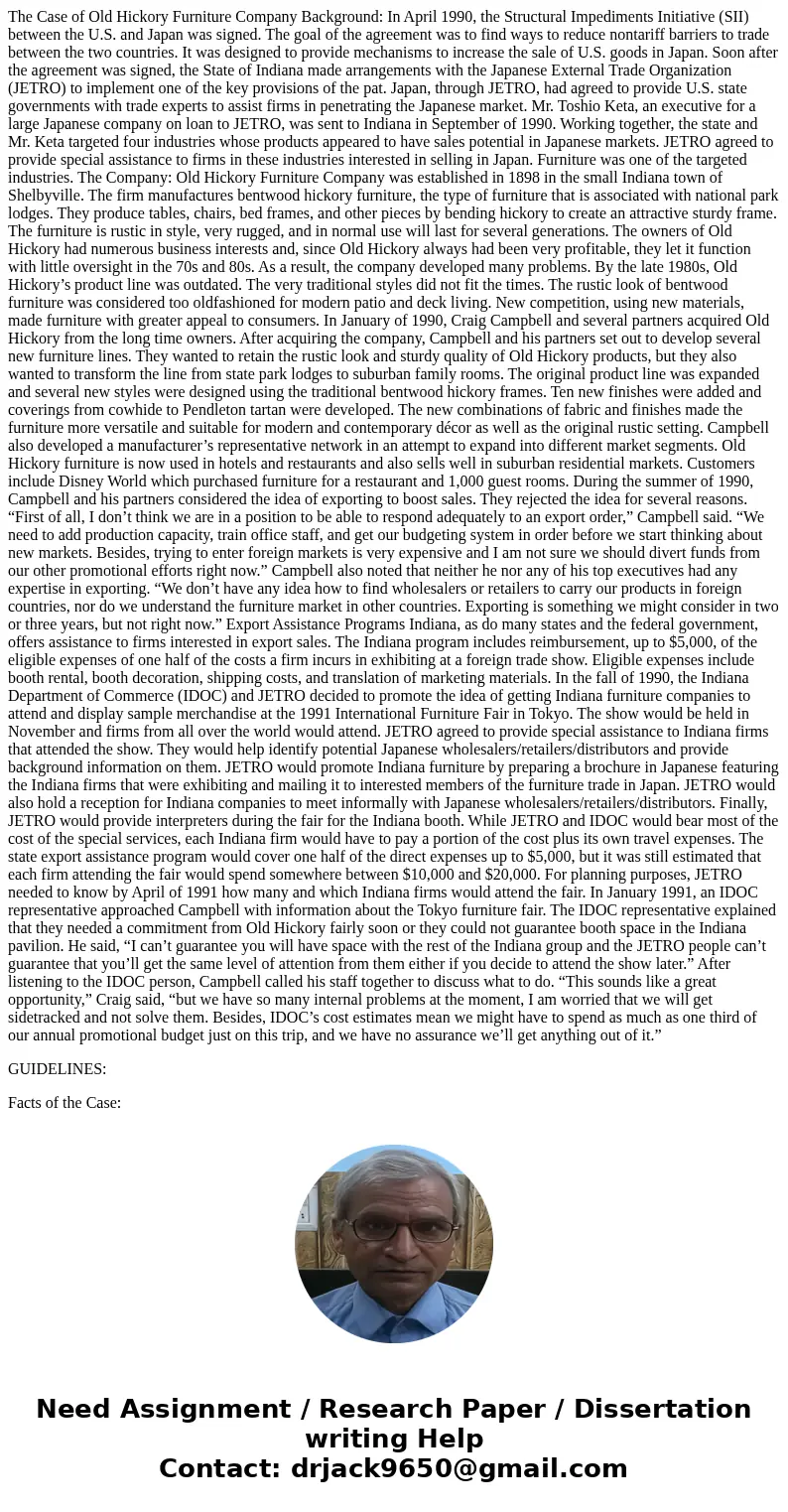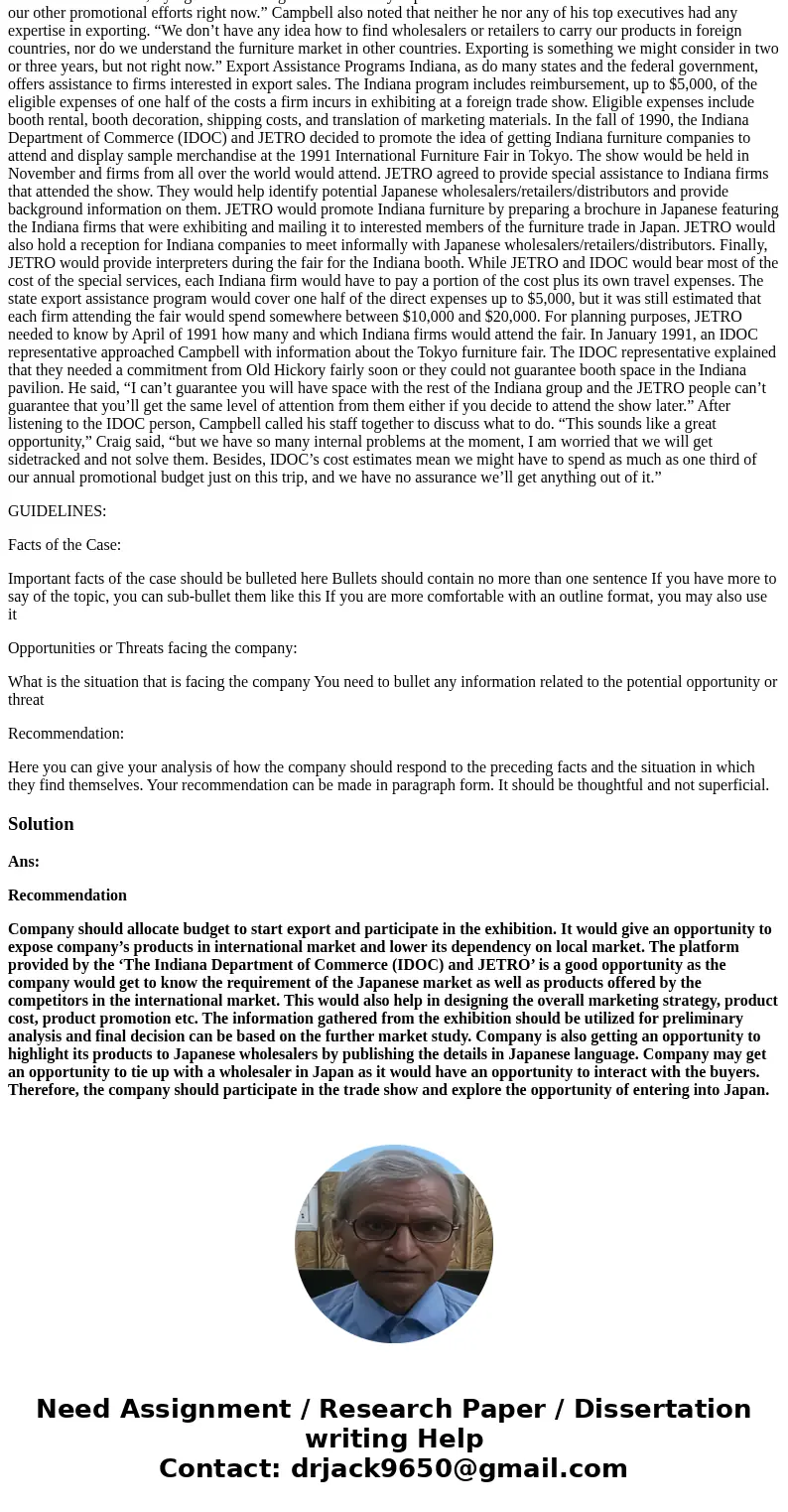The Case of Old Hickory Furniture Company Background In Apri
The Case of Old Hickory Furniture Company Background: In April 1990, the Structural Impediments Initiative (SII) between the U.S. and Japan was signed. The goal of the agreement was to find ways to reduce nontariff barriers to trade between the two countries. It was designed to provide mechanisms to increase the sale of U.S. goods in Japan. Soon after the agreement was signed, the State of Indiana made arrangements with the Japanese External Trade Organization (JETRO) to implement one of the key provisions of the pat. Japan, through JETRO, had agreed to provide U.S. state governments with trade experts to assist firms in penetrating the Japanese market. Mr. Toshio Keta, an executive for a large Japanese company on loan to JETRO, was sent to Indiana in September of 1990. Working together, the state and Mr. Keta targeted four industries whose products appeared to have sales potential in Japanese markets. JETRO agreed to provide special assistance to firms in these industries interested in selling in Japan. Furniture was one of the targeted industries. The Company: Old Hickory Furniture Company was established in 1898 in the small Indiana town of Shelbyville. The firm manufactures bentwood hickory furniture, the type of furniture that is associated with national park lodges. They produce tables, chairs, bed frames, and other pieces by bending hickory to create an attractive sturdy frame. The furniture is rustic in style, very rugged, and in normal use will last for several generations. The owners of Old Hickory had numerous business interests and, since Old Hickory always had been very profitable, they let it function with little oversight in the 70s and 80s. As a result, the company developed many problems. By the late 1980s, Old Hickory’s product line was outdated. The very traditional styles did not fit the times. The rustic look of bentwood furniture was considered too oldfashioned for modern patio and deck living. New competition, using new materials, made furniture with greater appeal to consumers. In January of 1990, Craig Campbell and several partners acquired Old Hickory from the long time owners. After acquiring the company, Campbell and his partners set out to develop several new furniture lines. They wanted to retain the rustic look and sturdy quality of Old Hickory products, but they also wanted to transform the line from state park lodges to suburban family rooms. The original product line was expanded and several new styles were designed using the traditional bentwood hickory frames. Ten new finishes were added and coverings from cowhide to Pendleton tartan were developed. The new combinations of fabric and finishes made the furniture more versatile and suitable for modern and contemporary décor as well as the original rustic setting. Campbell also developed a manufacturer’s representative network in an attempt to expand into different market segments. Old Hickory furniture is now used in hotels and restaurants and also sells well in suburban residential markets. Customers include Disney World which purchased furniture for a restaurant and 1,000 guest rooms. During the summer of 1990, Campbell and his partners considered the idea of exporting to boost sales. They rejected the idea for several reasons. “First of all, I don’t think we are in a position to be able to respond adequately to an export order,” Campbell said. “We need to add production capacity, train office staff, and get our budgeting system in order before we start thinking about new markets. Besides, trying to enter foreign markets is very expensive and I am not sure we should divert funds from our other promotional efforts right now.” Campbell also noted that neither he nor any of his top executives had any expertise in exporting. “We don’t have any idea how to find wholesalers or retailers to carry our products in foreign countries, nor do we understand the furniture market in other countries. Exporting is something we might consider in two or three years, but not right now.” Export Assistance Programs Indiana, as do many states and the federal government, offers assistance to firms interested in export sales. The Indiana program includes reimbursement, up to $5,000, of the eligible expenses of one half of the costs a firm incurs in exhibiting at a foreign trade show. Eligible expenses include booth rental, booth decoration, shipping costs, and translation of marketing materials. In the fall of 1990, the Indiana Department of Commerce (IDOC) and JETRO decided to promote the idea of getting Indiana furniture companies to attend and display sample merchandise at the 1991 International Furniture Fair in Tokyo. The show would be held in November and firms from all over the world would attend. JETRO agreed to provide special assistance to Indiana firms that attended the show. They would help identify potential Japanese wholesalers/retailers/distributors and provide background information on them. JETRO would promote Indiana furniture by preparing a brochure in Japanese featuring the Indiana firms that were exhibiting and mailing it to interested members of the furniture trade in Japan. JETRO would also hold a reception for Indiana companies to meet informally with Japanese wholesalers/retailers/distributors. Finally, JETRO would provide interpreters during the fair for the Indiana booth. While JETRO and IDOC would bear most of the cost of the special services, each Indiana firm would have to pay a portion of the cost plus its own travel expenses. The state export assistance program would cover one half of the direct expenses up to $5,000, but it was still estimated that each firm attending the fair would spend somewhere between $10,000 and $20,000. For planning purposes, JETRO needed to know by April of 1991 how many and which Indiana firms would attend the fair. In January 1991, an IDOC representative approached Campbell with information about the Tokyo furniture fair. The IDOC representative explained that they needed a commitment from Old Hickory fairly soon or they could not guarantee booth space in the Indiana pavilion. He said, “I can’t guarantee you will have space with the rest of the Indiana group and the JETRO people can’t guarantee that you’ll get the same level of attention from them either if you decide to attend the show later.” After listening to the IDOC person, Campbell called his staff together to discuss what to do. “This sounds like a great opportunity,” Craig said, “but we have so many internal problems at the moment, I am worried that we will get sidetracked and not solve them. Besides, IDOC’s cost estimates mean we might have to spend as much as one third of our annual promotional budget just on this trip, and we have no assurance we’ll get anything out of it.”
GUIDELINES:
Facts of the Case:
Important facts of the case should be bulleted here Bullets should contain no more than one sentence If you have more to say of the topic, you can sub-bullet them like this If you are more comfortable with an outline format, you may also use it
Opportunities or Threats facing the company:
What is the situation that is facing the company You need to bullet any information related to the potential opportunity or threat
Recommendation:
Here you can give your analysis of how the company should respond to the preceding facts and the situation in which they find themselves. Your recommendation can be made in paragraph form. It should be thoughtful and not superficial.
Solution
Ans:
Recommendation
Company should allocate budget to start export and participate in the exhibition. It would give an opportunity to expose company’s products in international market and lower its dependency on local market. The platform provided by the ‘The Indiana Department of Commerce (IDOC) and JETRO’ is a good opportunity as the company would get to know the requirement of the Japanese market as well as products offered by the competitors in the international market. This would also help in designing the overall marketing strategy, product cost, product promotion etc. The information gathered from the exhibition should be utilized for preliminary analysis and final decision can be based on the further market study. Company is also getting an opportunity to highlight its products to Japanese wholesalers by publishing the details in Japanese language. Company may get an opportunity to tie up with a wholesaler in Japan as it would have an opportunity to interact with the buyers. Therefore, the company should participate in the trade show and explore the opportunity of entering into Japan.


 Homework Sourse
Homework Sourse